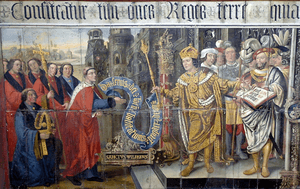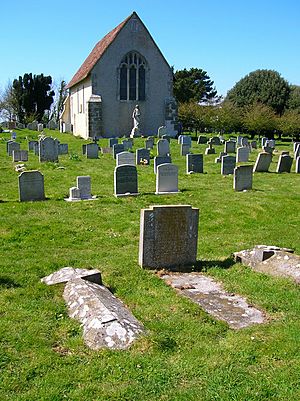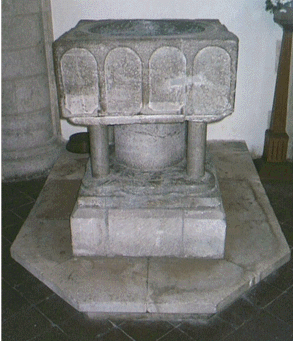St Peter's Church, Selsey facts for kids
Quick facts for kids St Peter's Church |
|
|---|---|

The church from the south-southeast
|
|
| 50°44′13″N 0°47′18″W / 50.7369°N 0.7884°W | |
| Location | High Street/St Peter's Crescent, Selsey, West Sussex, PO20 0NP |
| Country | United Kingdom |
| Denomination | Church of England |
| Website | http://www.stpetersselsey.com |
| History | |
| Status | Parish church |
| Founded | 13th century |
| Dedication | St Peter |
| Architecture | |
| Functional status | Active |
| Style | Norman with Victorian Chancel |
| Administration | |
| Parish | Selsey |
| Deanery | Chichester |
| Archdeaconry | Chichester |
| Diocese | Chichester |
| Province | Canterbury |
St Peter's Church is a historic church in Selsey, West Sussex. It was first built in the 13th century. What's really interesting is that this church wasn't always in its current spot! It used to be about two miles north, at a place called Church Norton. This was where St Wilfrid built his first monastery and cathedral.
A Look Back: The Church's History
Let's go back in time over 1300 years! Around 680 AD, a special person named St Wilfrid, who was a bishop, came to Sussex. He helped teach the people of the South Saxons about Christianity. Wilfrid started a monastery (a place where monks live and pray) in Selsey. This was at the entrance to Pagham Harbour, where Church Norton is today.
After King Caedwalla took over the South Saxons around 685 AD, the area became part of the Diocese of Winchester. But around 705 AD, the church district for Sussex was set up again. Wilfrid's monastery then became the main church for the area, like a cathedral.
There's a cool painting in Chichester Cathedral by Lambert Barnard. It shows King Caedwalla and St Wilfrid talking. If you look closely at the top left corner, you can see what Selsey Church and its monastery might have looked like in 1519!
Did you know the old church had a bell tower that wasn't even attached to it? It was probably built much earlier, maybe around the 11th century. It might have been part of a small fort. People in 1662 said there was "never any steeple belonging to the church, but a tower formerly belonging to a ruined castle". This old tower fell down in 1602. A new one was built in 1662, but this time it was connected to the church.
In 1075, the main church office (called the See) moved from Selsey to Chichester. People aren't exactly sure where the old Selsey cathedral was. Some stories say it's under the sea, and you can hear its bell ringing during storms. But this is probably not true. It's more likely that the church built in the 13th century was on the same spot as the old cathedral.
By the mid-1800s, most people had moved to what is now modern Selsey. This was because the coastline was eroding, and the old church was getting too close to the sea. So, people decided to move the church to the new town center.
Between 1864 and 1866, the church was carefully taken apart, stone by stone. Then, it was rebuilt in its current spot. When it was rebuilt, it faced North instead of East. The old part of the church called the chancel stayed at Church Norton. It was dedicated to St Wilfrid in 1917 and is now known as St Wilfrid's Chapel. A new Victorian chancel was added to the rebuilt church. The new St Peter's Church was officially opened on April 12, 1866.
Inside the Church: What It Looks Like
As we learned, the church was moved from Church Norton in the 19th century. Church rules meant that the main part of the church could be moved, but not the chancel. So, the old chancel stayed behind.
Plans were made of the church in its original place. An architect named James Piers St Aubyn was in charge of the rebuilding in 1865. The rebuilt church looked very much like the original. The only new parts were the Victorian chancel and a small room called a vestry. The church has two rows of arches, each with three sections. These arches separate the main area (the nave) from the side aisles. They were first built in the late 12th century.
The large window at the east end has three pointed lights. It has fancy stone patterns from the late 14th century.
On the south wall, there are two pointed spaces. The one on the east is now a credence table (a small shelf for church items). The one on the west is a piscina (a basin for washing church vessels). These look like they were added later than the 13th century.
The north wall also has two pointed windows, similar to those on the south. There might have been a third one that is now blocked up. On the outside of this wall, you can see a mark where the roof of another building used to join it.
The church has a special cup called a chalice from the time of Queen Elizabeth I. It also has a very old font (a basin for baptisms). An architect named Ian Nairn thought the font was made around 1100. However, other historians think it might be a bit later. The font is made of Purbeck marble. It's a common type from the 12th century in the southeast of England. It has a shallow round basin on a square base, supported by one large central column and smaller columns at the corners. The architect Philip Mainwaring Johnston designed the reredos (a decorated screen behind the altar).
St Peter's Church is a Grade II* listed building. This means it's a very important historic building.




